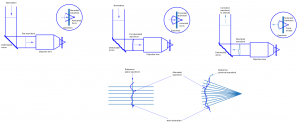Adaptive optics for microscopy include deformable mirrors (DMs) and spatial light modulators (SLMs). Both of these components are designed to dynamically counteract aberrations, enabling the microscope to produce clear, aberration-free images. Unlike static optics, these adaptive optics are equipped with sensors that report on their environments and are able to change the degree and form of their correction as conditions change.
Studying deep tissue with a microscope can be problematic. No matter how advanced your microscope might be and how ideal your optical components are, spatial variations in the refractive index of the substance under investigation will cause significant aberrations. These aberrations are there even when the tissue is relatively thin, but the problem is compounded as thickness increases.
Correcting for these aberrations within the microscope would allow you to produce high-resolution images of tissue hundreds of micrometers thick. But the very nature of these aberrations is that they vary. A static corrective lens might be designed to work perfectly for one particular sample, but it would be useless when the sample was changed. That’s why researchers are turning to adaptive optics— optics that can transform themselves dynamically to respond, real-time, to the actual aberrations caused by a sample.
Adaptive optics for the microscope include a sensor capable of measuring aberration throughout the sample— a wavefront sensor, perhaps. They also include a dynamic component such as a deformable mirror (DM) or liquid spatial light modulator (SLM). A sequence of measurements is taken by the sensor, then the DM or SLM responds by providing equal, opposite aberrations that exactly counteract the aberrations in different parts of the image.

The Image shows how adaptive optics for microscopy dynamically corrects the aberrations caused by spatial variations in the refractive index of the sample
Adaptive microscopes are typically powered by either of two special adaptive systems: deformable mirrors or liquid crystal spatial light modulators. These optical systems are quite different, but they offer the same results: on-the-go aberration correction that enables high-resolution microscopy. A third option, transmissive adaptive elements, has not yet been widely adopted.
Deformable Mirrors
A deformable mirror features a reflective surface— either continuous or segmented— that can be deformed by the action of actuators. These actuators are acted upon by electrostatic, electromagnetic, or piezoelectric forces, and each one deforms only a small part of the mirror. It is the combined action of tens or hundreds of these tiny actuators that transforms the mirror in response to aberration data gathered by the sensors.
These mirrors can provide high reflectance over a broadband and are polarization independent. They are a good choice for situations when several wavelengths of light are to be corrected simultaneously when working with weak light or with fluorescence.
Spatial Light Modulator
A liquid crystal on silicon (LCOS) spatial light modulator (SLM) is formed by sandwiching a thin layer of liquid crystal between a sheet of silicon and another of glass. Molecules in the liquid crystal can be moved by means of voltages applied to electrodes on the silicon backplane, changing the optical properties of the liquid. SLMs tend to have low optical efficiency as compared to DMs. They are wavelength dependent and should only be used with parallel light, but can do well when paired with lasers.
Adaptive optics were first used with laser scanning systems such as confocal or two-photon fluorescence microscopes. The field quickly expanded, however, and today there are many types of microscopes that are compatible with adaptive optics.
These include parallelism scanning systems, widefield systems, and multi-photon fluorescence microscopes. Just how the adaptive optics are integrated within the microscope will depend on the image formation process as well as the physical configuration of the microscope.
In a multi-photon or two-photon microscope aberrations affect image quality only through the illumination path, and it is on this path that the dynamic adaptive element should be placed. For a confocal microscope, in contrast, both the fluorescence emission and laser illumination path need aberration correction. This does not mean that two separate corrective systems are necessary: often, a single deformable mirror can be placed in the common path part of the optical train. In a widefield imaging microscope, the correction should be placed in the detection path, and in a structured illumination microscope, corrective elements are placed in both imaging and illuminating paths.
Shanghai Optics is proud to be a premium producer of adaptive optics for microscopy, with extensive expertise in both deformable mirrors and spatial light modulators. Contact Shanghai Optics today! We’d be more than happy to discuss your projects and how to best bring them to fruition.
References
Booth, M. Adaptive optical microscopy: the ongoing quest for a perfect image. Light Sci Appl 3, e165 (2014). https://www.nature.com/articles/lsa201446
Girkin, Poland, & Wright. Adaptive optics for deeper imaging of biological samples,
Current Opinion in Biotechnology, Volume 20, Issue 1, 2009, Pages 106-110. https://www.sciencedirect.com/science/article/abs/pii/S0958166909000202
Marx, V. Microscopy: hello, adaptive optics. Nature Methods 14, 1133–1136 (2017).
https://doi.org/10.1038/nmeth.4508